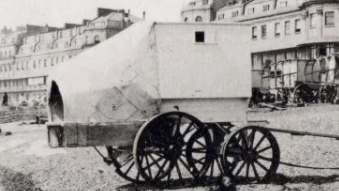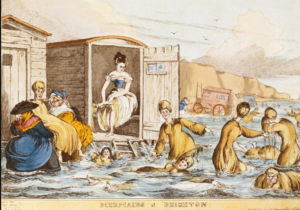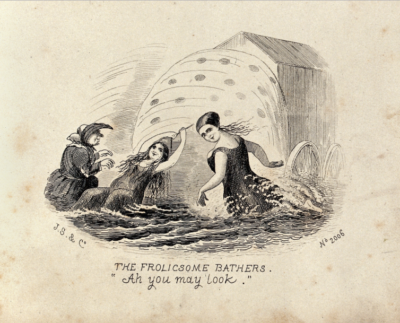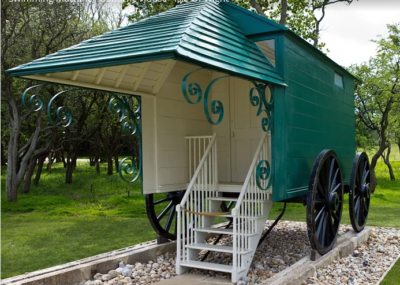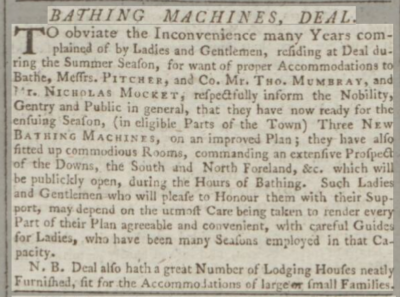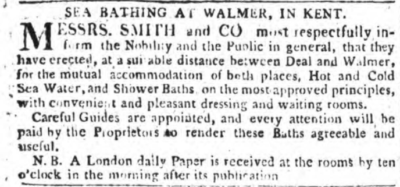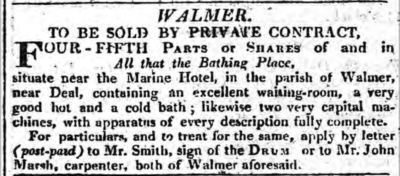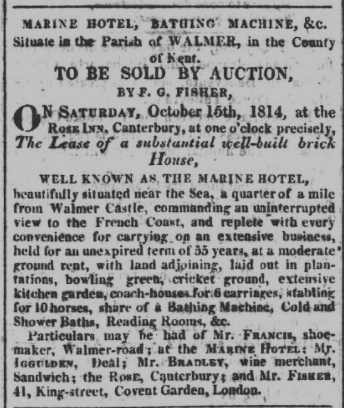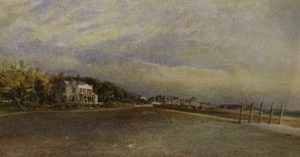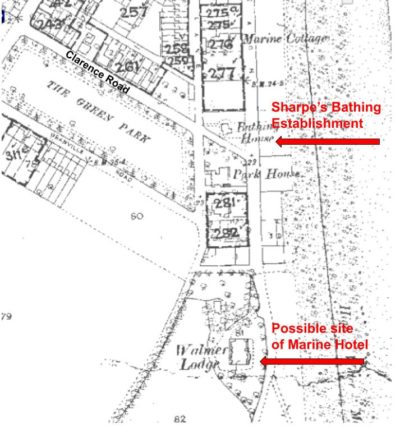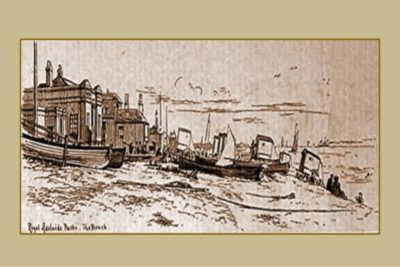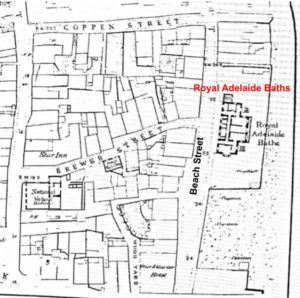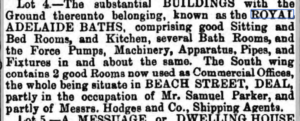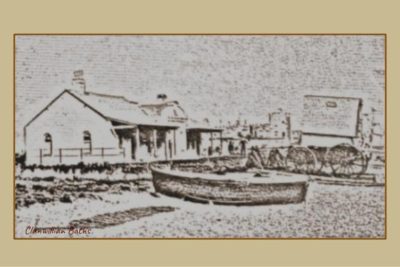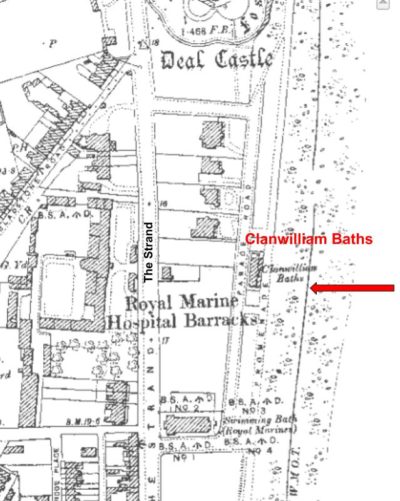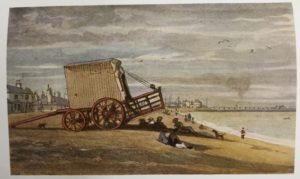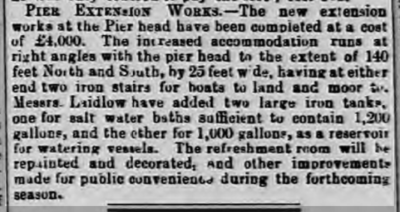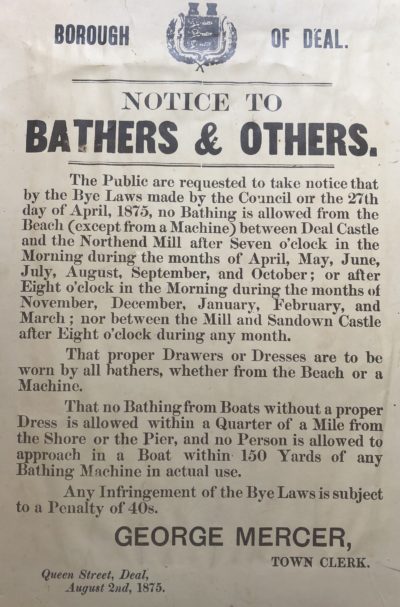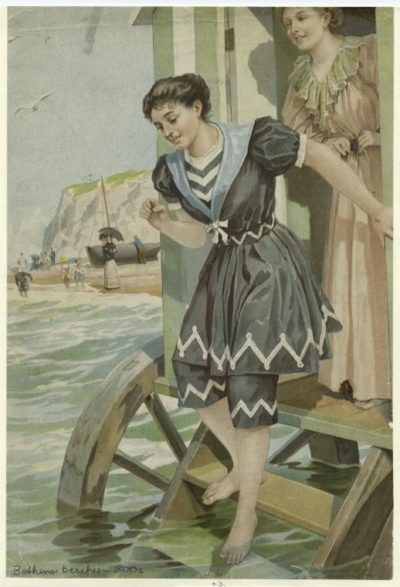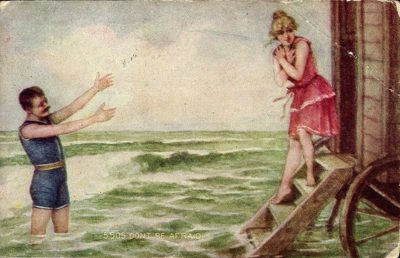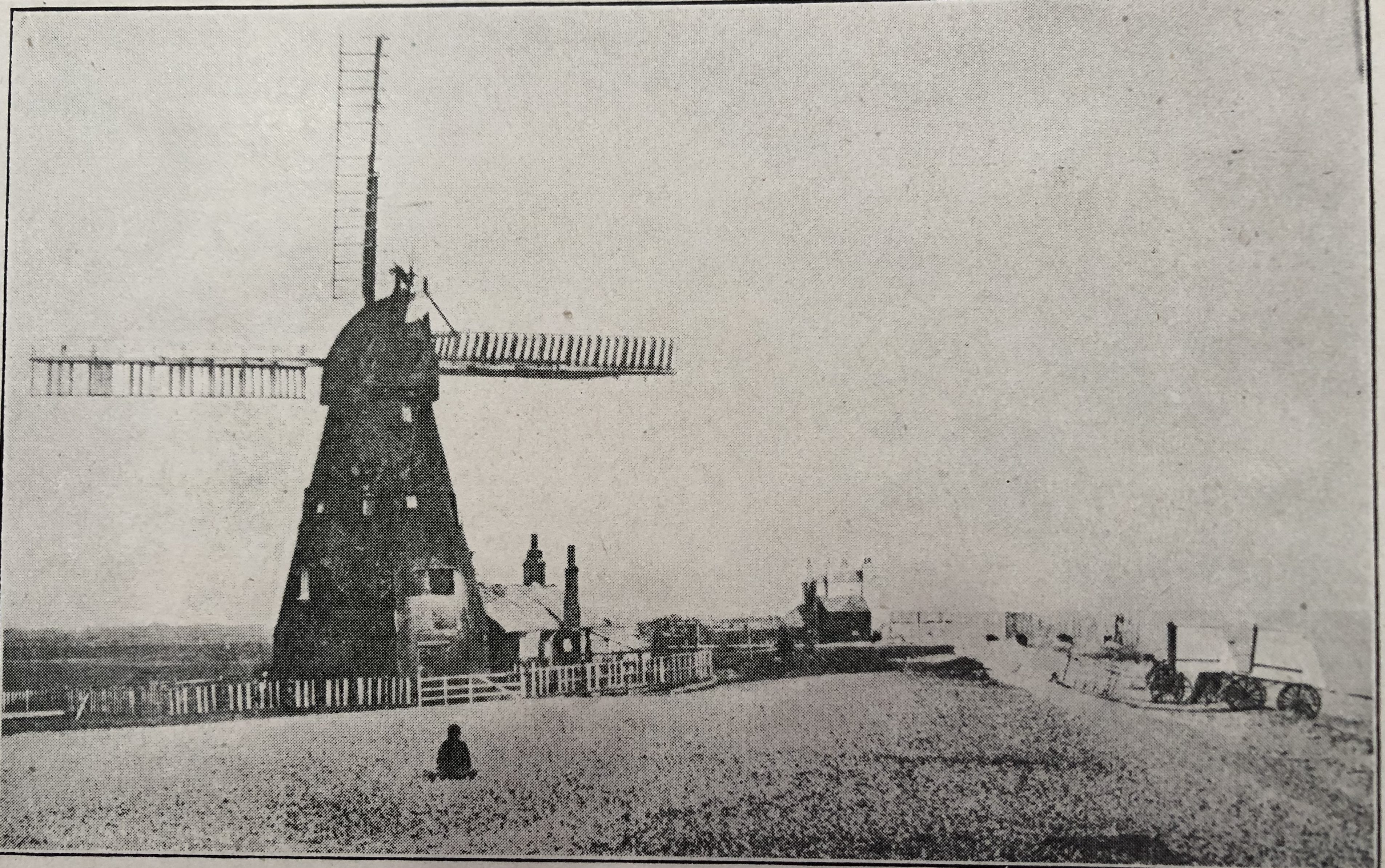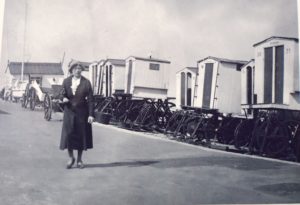Follow us on Facebook @FHofDW
Bathing in Deal
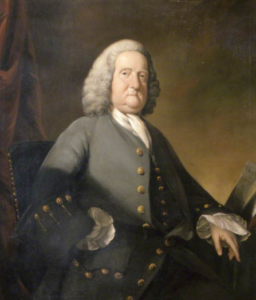
————————————————————– Dr. Richard Russell by Benjamin Wilson 1721–1788 Public domain
As early as the late 1600s, Dr Robert Wittie of Hull began promoting the health benefits of sea bathing and around 1730, Peter Shaw, a spa doctor and chemist in Scarborough wrote about the advantages of ‘Bathing in the Sea.’
In 1753, Richard Russell published ‘A Dissertation Concerning ‘The Use of Sea Water in Diseases of the Glands.’ He claimed to have brought about dramatic improvements in his patient’s health, just by bathing in the sea. He even had a catchy slogan, borrowed from Euripides, “The Sea washes away all the Evils of Mankind” to help promote his belief and * the business he derived from it.
Other doctors started to prescribe ‘sea-bathing’ which encouraged those who could, to travel to the coast seeking out suitable places to take the treatment as prescribed by their physician. In the early days that may even have included ‘ taking the waters’ at the fashionable Spa towns such as Bath, Tunbridge Wells and Harrogate.
As with all new-fangled ideas, there were those who spoke out against them and also those who embellished them. In 1775 a Doctor White warned against unsupervised bathing as some of his patients, who ignored his advice, apparently died. Others advised on various types of diets to accompany the sea-bathing that they had prescribed. Others advised their patients to starve themselves before bathing.
Nonetheless, those enterprising people of the coast started to cater to this newly fashionable craze. Not only did they open up their houses to provide visitors with accommodation but realising that bathers needed somewhere to change, and in some privacy too, Bathing-machines were constructed.
Who invented these ’machines’ we don’t know with any certainty. Benjamin Beale is often mentioned but was more likely to have been responsible for the design of the canopy. John Setterington’s engraving dated 1735 depicts Scarborough beach with several bathing machines on it, so we do have a rough date for their first appearance in England.
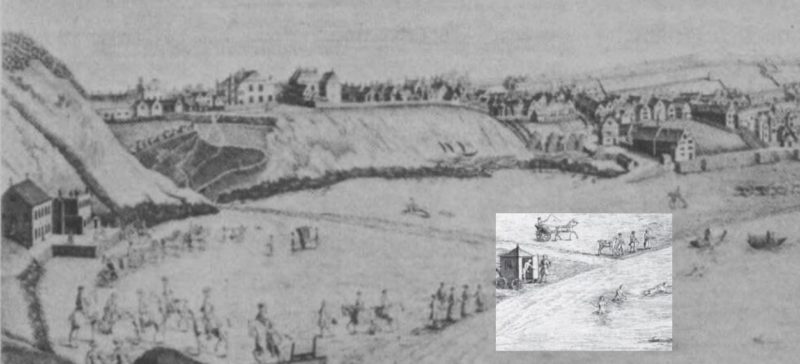
Illustrated London News August 1 1970 John Setterington’s engraving of the first bathing machine at Scarborough, 1735. The enhanced area shows a wooden hut on four wheels, with a window and an attendant holding the door open for the bather.
The Bathing Machine
These ‘machines’ were basically a wooden or canvas cabin on wheels. The bather would enter via steps and closing the door behind them so they could disrobe in private. After being dressed in their swimming attire the bathing machine was drawn by a horse, or manpower, out into the water. Once the water was at floor level the horse, if used, was detached and moved away leaving the occupant to alight straight into the sea.
Some of these machines had a covered wire ‘cage’ at the front enabling the nervous bather to ’dip’ into the sea protected from the waves.
Employment
‘Sea-bathing’ brought new employment and occupations. The machines needed building and maintaining and the horses needed caring for. Enterprising people exploited the need for Bathing-machine Proprietors who were essential to the smooth running of this new enterprise.
Another sea-bathing occupation arose, that of the professional ‘dipper’, whose job it was to assist, particularly the nervous female, in her sea-bathing while ensuring her safety.
Of course, it just wouldn’t be proper for the ‘naturally innocent’ ladies of the day to observe a partially or even a fully nude gentleman. So parliament, in 1846, brought in the ‘Baths and Washhouses Act’ giving local councils the power to bring in bye-laws enabling them to enforce segregated areas, for male and female bathers, this continued until about 1901 when the law was finally abolished.
Queen Victoria
Even Prince Albert believed in the benefits of “sea bathing” and had an especially ornate bathing machine, including a veranda and toilet, built for the Queen. In her diary, dated July 1847, she “…for the first time in my life…” bathed in the sea and found it “…delightful…” she too had a bathing woman to aid her during her time in the sea.
Bathing and Dipping at Deal
John Dixon in 1753 had taken over the East India Arms fitting it “..out as an inn and tavern…”. The East India Arms, later just India Arms, is now the Amusement Arcade on the corner of Beach and King Street.
A year later, in May 1754 we find that he had added bathing machines to his ‘seaside’ business and was advertising in the Kentish Post
Deal even with its minimal resort facilities, compared to resorts such as Brighton and Margate, still managed to attract Royal Patronage. So much so that in 1782 when the one-year-old Prince Alfred was inoculated against smallpox he was sent to Deal to recover. Sadly the poor young prince after leaving Deal, never having recovered from the inoculation, died a year later.
We do not know, for certain, how long John Dixon maintained his Bathing-machines. Certainly no later than 1766 when his burial is recorded at St. George’s Church.
In 1788 we find three men, Nicholas Mockett, William Pitcher & Thomas Mumbray, were not only advertising their Bathing Machines “…of an improved Plan…” but with “…careful Guides for Ladies…” adding that “…Deal also hath a great number of Lodging Houses…”
Two years later ‘The Universal British Directory of Trade, Commerce, and Manufacture’ show that Nicholas Mockett and William Pitcher were still in business and a J Wood had joined them. Perhaps because of the effects of the Napoleonic Wars on the town and its subsequent decline, by 1811 The London & County Directory only lists Samuel Trott as the Master of the Bathing Machines in Deal.
Bathing in Walmer
Though in 1807 Messrs Smith & Co had set up their hot and cold sea-bathing facility in Walmer. This business was not to last long and by 1811 four-fifths of the shares were being offered for sale.
It is possible that these bathing rooms became known as the ‘Union Bathing Rooms’ which again went up for sale in 1817 and were later called The Walmer Baths.
The Marine Hotel as mentioned in the advertisement has long since gone being demolished, according to Charles Elvin in his Records of Walmer, to make way for Walmer Lodge which once occupied the land between Liverpool Road and the Beach, south from Alexandra Road.
Walmer Baths or Sharpe’s Bathing Establishment
A list of Alehouse keepers states that John Francis was registered as the landlord of the Marine Hotel in 1812 followed by Richard Hayman and in 1818 by Edward Sharpe. When the Hotel was sold Edward then continued to run the Bathing Establishment.
Pigot’s directory of 1840 lists Walmer Baths on The Beach, with Edward Sharp as its proprietor, though he had died the year before. These baths were * on the corner of Clarence Road and according to CR Elvin’s Records of Walmer, * known locally as ‘Sharpe’s Bathing Establishment’ which he describes as a “…low wooden construction…” that also “…once served the purpose of a Reading Room…”
The Tithe Apportionments of 1843 and the 1851 census both tell us that Edward’s wife, Elizabeth, and their children were running the ‘Bathing Establishment’ but now owned by G T P Leith.
Robert, Elizabeth and Edward’s son, took over the business and was the proprietor there in 1881, he died in 1883 and it seems the baths were closed soon after.
Royal Adelaide Baths
Deal and Walmer was not to become the Brighton or Margate of its day, though not for lack of trying. In 1834 after years of decline, it was decided to improve the town and an “Improvement Committee” was formed. It was this group of local dignitaries and prominent businessmen who brought about the building of a new sea wall and the promenades or parades.
Bathing Rooms were part of the improvement plan so when a private company was formed putting forward a plan, it was agreed upon. In 1836 Royal patronage was again given to Deal when Queen Adelaide, wife of King William 1V, gave her name to the ‘Royal Adelaide Baths’. These were also listed in Pigot’s Directory and were situated on the Beach opposite to where Adelaide House now stands.
The building itself we are told was of elegant design and “…was admired for its classical taste…” Inside there was a Reading Room, a library and waiting rooms.
Here there was no need to enter the cold waters of the channel as the”…‘bathing’ facilities included Hot, Plunging, Vapour and Shower Baths…”
These baths or plunge pools would have been filled by servants bringing the water, probably in yoked buckets, from the shore or if you required a freshwater bath, from the nearby wells. Force pumps are mentioned in a later advert so maybe these too were used. And should you still be inclined to take a dip in the sea, you could always hire a bathing machine from Jacob Vile.
Sadly these bathing rooms were not to be a success so they went up for sale by auction on 1st June 1841. The particulars of sale state that The Royal Adelaide Baths was built at considerable expense in 1836 and that it extended from Beach Street to the sea with a Promenade protected by a substantial sea wall.
We don’t know who actually purchased the baths, but Thomas Taylor was the proprietor when his first child, Annie, was born there in 1861. We assume as their second child, Charlie, was born in Sandwich in 1864 that Thomas had left the establishment by then. Certainly, by 1871 a Samuel Parker was the proprietor. Then in 1872 Adelaide Baths were again up for sale.
Again we were unable to discover who purchased the baths, or even if it was sold, though it seems that it remained empty for a number of years. For the final time in 1882 it was put up for sale at which point the council purchased and demolished it thus extending North Parade.
Clanwilliam Baths
Clanwilliam Baths, which opened in 1878, and named after the then Captain of Deal Castle, Earl Clanwilliam, was in the ownership of a Mr Thomas Lewis. The building was described as being a long low building with a roof garden. Inside, on the ground floor, it was divided into a dozen or so 9ft by 6ft cubicles each with a bath. Stairs took you down into a cellar where there was a large seawater bath. These baths, just like at The Royal Adelaide Baths, were filled for you with seawater being brought up from the shore.
Here too you could hire a bathing-machine to take you down to bathe in the sea itself. Perhaps they were the same machines that John Lewis Roget had himself painted just before the baths were built.
‘Bathing Machine with Cradle’ was painted in about 1874 and the scene is described in ‘Sketches of Deal, Walmer and Sandwich’ as “…part of the beach in front of the building known as the Hospital Barracks…”
Miss Catherine Brett was the proprietress during the 1880s but soon after the Clanwilliam Bathing facility went into decline and by 1911 the baths had closed. Though, unlike the other bathing establishments of Deal and Walmer, the Clanwilliam Bathhouse building itself survives as a private residence.
The Pier ‘Salt-water Baths’
In 1861 the Deal and Walmer Pier Company was formed, and part of the attractions planned for the new Pier was a small Pavilion with ‘salt-water baths’ that were updated in 1878. How long these ‘baths’ were in operation for we don’t know as by about 1886 they had been replaced by a small concert hall.
Bathing Bye-Laws in Deal and Walmer
In 1875 Deal Borough Council put up notices informing Bathers of the restrictions on the times and places for bathing and the proper mode of dress “…to prevent Indecent Exposure.”
The Bye-laws as to Bathing of 1875 also stated that “No Proprietor or Attendant of any Bathing Machine shall allow any Male or Female persons above the age of Nine years to use such machine at one and the same time.”
Bye-law enforcement
We know from the Deal, Walmer & Sandwich Telegram that these Bye-laws were being strictly enforced. In July 1888 two boys Elgar Baynes aged 12 and Charles Roberts aged 13 were charged with “…unlawfully bathing from an open beach after the hour of seven in the morning without proper bathing dress….” they were fined 6d each with 5/- costs or seven days.
Another case in 1890 where yet another two boys, Albert Elliott and Edward Magee, pleaded guilty to bathing without proper bathing dress after eight o’clock in the evening, which they said they thought they could do. The Magistrate Alexander Bird said, “…this kind of offence could not be passed over, but taking into consideration what the boys had said, he would not convict them, but on the parents agreeing to pay 2/6d in each case towards the costs…” These were duly paid. The paper went on to comment that “It was more a warning to the public than punishment to the boys”
Bathing Machine
Horse or man-powered bathing machines had, at some point, given way to winches on Deal beach, probably due to the difficulties of hauling these heavy contraptions up and down the shingle banks.
Once the bathing establishments had fallen out of use, which seems coincidentally to have coincided with the law for segregated bathing areas being lifted, the use of bathing machines also began to go into decline. Bathing costumes though became very de rigueur!
The Last Deal Bathing Machine Proprietors
In 1874 through to 1882 Fishmonger Henry Trapp had his Bathing Machines on the seafront at Deal and further along, at Sandown, Thomas Cattermole offered his bathing machines to visitors between 1881 and 1891.
Then from 1903 to 1918 Walter Redsull, John Portige Magee and Francis Adams are listed in Kelly’s Directory as Bathing Machine Proprietors in Deal. They too had other occupations with the ‘bathing-machine’ business bringing in added income.
By the 1920s Tommie Upton’s ‘Bathing Machines’ were to be seen on the seafront. These were to be the last here in Deal as by 1934 they had gone out of fashion and finally fell into disuse. So by September of that year, they went up for sale.
